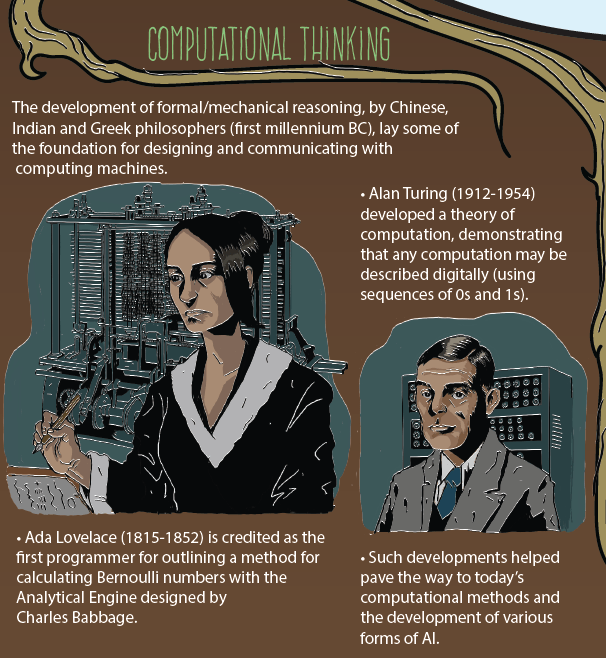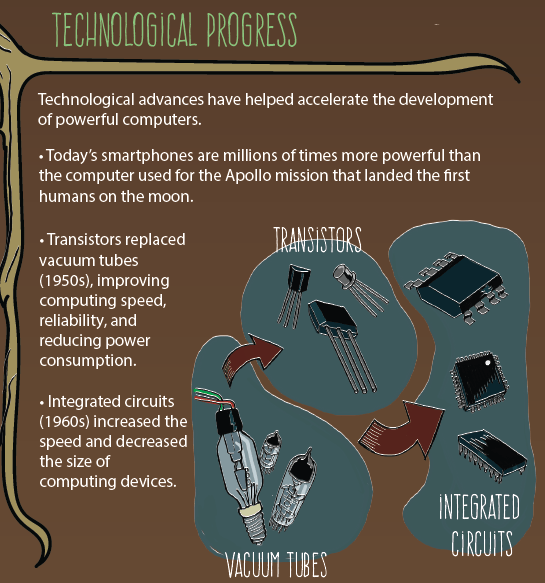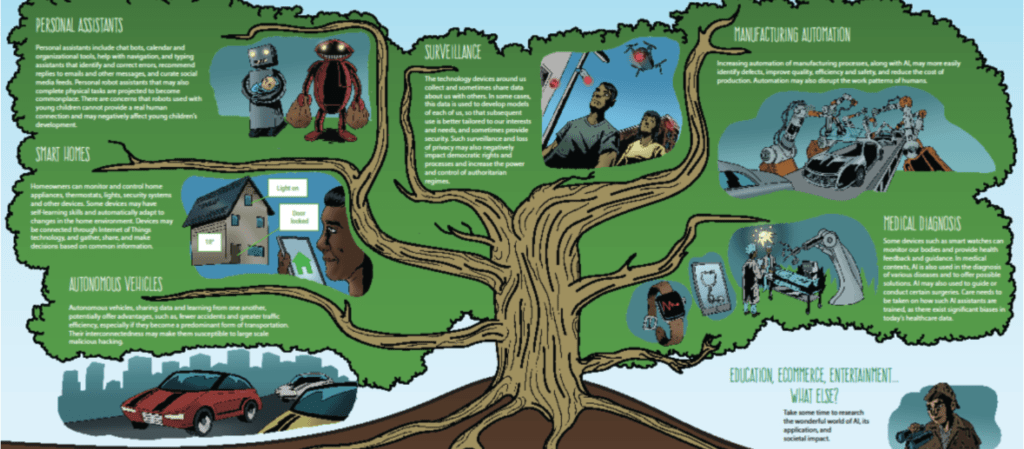Teaching prompts and activities

MENU of teaching prompts & activities
Follow the links below for teaching prompts and activities for using our AI resources in your classroom.
1. Roots & fruits of AI (infographic)

2. Simple machines & machines that think (graphic story)

- Simple machines
- Wedge
- Inclined plane
- Lever
- Wheel & axle
- Screw
- Pulley
- Machines that think
- Can machines think?
- Developmental robotics
- How machines see our world
- Reinforcement learning
- Supervised learning
- Unsupervised learning
- Can a machine have a personality?
3. Bots & bees (graphic story)

- Where have the insects gone?
- Bees do the waggle walk
- Sensors, data & machine learning
- Animal communication
- Robot bees
- New bees (spoof)
4. Talking to whales (graphic story)

- About sperm whales
- Whale communication
- Whale songs
- Whale language
- What would you say to a whale?
5. AI & society

- How AI can help tackle environmental challenges
- UN environmental program
- Democracy, social media & AI
- The factory of lies
- Regulating AI
- Potential dangers of AI
- Regulation of AI
6. Indigenous Knowledges

- Context
- Colonialism & climate change
- Natural law
- How we lived
- Relationship with the land
- The good life
- AI and Indigenous Knowledges
- An app
7. Apps

- Real world vs abstract view
- Decision trees
- Automata
- Simulating forest fires
1. ROOTS & FRUITS of AI

Our Roots & Fruits of AI infographic provides an overview of the origins of AI (roots) and its use and implications for society (fruits).
You may download ($0) and print the PDF of the infographic as a 22 x 17 inch poster.

ROOTS OF AI
What led to the development of AI?

Below we identify 4 elements that played important roles in the development of AI:
- Human imagination
- The development of mechanical automata
- The development of formal mechanical reasoning (computational thinking)
- Technological progress
1. Human imagination

Humans use their imagination to envision what might be. There is a long history of mechanical beings in myths and legends. Robots with human form have been imagined in works of fiction.
Thinking/discussion prompts:
- What mechanical beings have you comes across in stories or movies?
- What were they designed to do?
- What was their role in their story or movie?
Activities:
- Design a robot.
- What does your robot look like? Draw your robot.
- What can your robot do? What can’t it do?
- Where will your robot live?
- What will change in your life because of your robot?

- Predict the future.
- Imagine our world 20 years from now.
- What might be the relationship between humans and robots?
- How might our society be different? How might it be still the same?

- Imagine a society that abandoned its technology.
- What technology do you think our society should abandon?
- Why?
- How would our society change?
- What technology do you think our society should never abandon? Why?
- What technology do you think our society should abandon?

2. AUTOMATA

Technological progress increased an interest in engineering automata: mechanical devices that mimic some aspect of life.
Thinking/discussion prompts:
- What are some mechanical or electronic devices in your home or in your neighbourhood that mimic some aspect of daily life?
- Teacher note: a washing machine (washing clothes) and a traffic light (directing traffic) are two examples.

Activities:
- Design an abstract automaton.
- View and discuss the Abstract Automata video.
- Work in pairs to create the abstract automaton for a vending machine where snacks cost 25 cents.
- Cellular automata
- Run the Python code for producing Cellular Automata.
- Edit the code to produce new variations.

3. Computational Thinking

How did computers become “thinking” machines?
Thinking/discussion prompts:
- Do machines think?
- In what way is machine thinking different than human thinking?
- In what way is it similar?
- Are machines better at thinking than humans?
- In what way are they are they not?
Activities:
- Historical developments in computational thinking.
- With your partner, select and research a historical person who contributed to the development of machines that “think”. For example, Ada Lovelace, Charles Babbage, and Alan Turing.
- Create in infographic about their life and contributions.
- Or, author the dialogue for an interview skit with a person who contributed to the development of machines that “think”.
- With your partner, select and research a historical person who contributed to the development of machines that “think”. For example, Ada Lovelace, Charles Babbage, and Alan Turing.

- Recent developments in AI.
- With your partner, select and research a recent AI development.
- Create in infographic about this AI development.
- How might this development change our lives?
- With your partner, select and research a recent AI development.

4. Technological progress

Technological advances have helped accelerate the development of powerful computers and the development of AI.
Thinking/discussion prompts:
- What technological advances have you seen in your lifetime?
- For cellphones?
- For automobiles?
- For appliances?
- What else?
Activities:
- Research the history of computer development.
- How are today’s computers different from the earliest ones?
- How has the use of computers changed over time?
- How has AI developed over time?
- How has the use of AI changed over time?

FRUITS OF AI

Thinking/discussion prompts:
- Which “fruits” of AI have the greatest impact on society? Why?
- Autonomous vehicles?
- Smart homes?
- Personal assistants?
- Surveillance?
- Manufacturing automation?
- Medical diagnosis
- Something else?
Activities:
- Research and develop an infographic for a “fruit” of AI of interest to you.
- What is its function?
- What is its effect on society?
- How might it evolve in the next 10-20 years?
2. FROM SIMPLE MACHINES TO MACHINES THAT THINK

Our graphic story provides an historical overview of simple machines and an overview of the development for thinking machines.
You may download ($0) and print the PDF of the graphic story.

SIMPLE MACHINES
1. WEDGE
xxx

2. INCLINED PLANE
xxx

3. LEVER
xxx

4. WHEEL & AXLE
xxx

5. SCREW
xxx

6. PULLEY
xxx

MACHINES THAT THINK
7. CAN MACHINES THINK?
xxx

8. DEVELOPMENTAL ROBOTICS
xxx

9. HOW MACHINES SEE OUR WORLD
xxx

10. REINFORCEMENT LEARNING
xxx

11. SUPERVISED LEARNING
xxx

12. UNSUPERVISED LEARNING
xxx

13. CAN A MACHINE HAVE A PERSONALITY?
xxx

3. THE BOTS & THE BEES

You may download ($0) and print the PDF of the graphic story.

4. TALKING TO WHALES

You may download ($0) and print the PDF of the graphic story.

5. AI & SOCIETY
1. AI & ENVIRONMENTAL CHALLENGES
xxx
2. DEMOCRACY, SOCIAL MEDIA & AI
xxx
3. REGULATING AI
xxx
6. INDIGENOUS KNOWLEDGES
… coming soon …
7. APPS
1. REAL WORLD VS ABSTRACT VIEW
xxx
2. DECISION TREES
xxx
3. AUTOMATA
xxx
